Summary
Revista Brasileira de Ginecologia e Obstetrícia. 2010;32(1):47-54
DOI 10.1590/S0100-72032010000100008
ABSTRACT About 1% of all pregnancies present structural anomalies. During the last three decades, various experimental studies in large animals, associated with the technological advance of diagnostic imaging and fetoscopy equipment, have led to great progress in the knowledge of the pathophysiology of various congenital defects. Such knowledge applied to intrauterine correction of abnormalities has transformed the natural history of several previously fatal diseases, leading to a considerable number of survivors. Fetal intervention, such as open fetal surgery, may be indicated in meningomyelocele or in congenital cystic adenomatoid malformation, and in sacrococcygeal teratoma, which lead to secondary fetal hydropsy. Besides, minimally invasive procedures using fetoscopy may have application in congenital diaphragmatic hernia, in feto-fetal transfusion, in twin pregnancies with an acardiac fetus, in the posterior urethral valve, and in hypoplasia of the cardiac chambers, with good results. Even though open fetal surgery and minimally invasive procedures are still experimental and still need to be fully validated, a correct echographic diagnosis and the patient's referral to tertiary centers providing multidisciplinary fetal care contribute to the survival of fetuses with congenital diseases of usually fatal evolution.
Summary
Revista Brasileira de Ginecologia e Obstetrícia. 2008;30(9):470-479
DOI 10.1590/S0100-72032008000900008
Adequate postpartum contraception is recommended in order to prevent mother and infant morbidity. The mother-infant benefits of lactation are well recognized, and exclusive, regular and frequent breastfeeding is an effective contraceptive method for amenorrheic patients. However, the resumption of fertility varies among women and access to health services is not guaranteed in many regions of the world. We searched the articles in Medline (PubMed) related to the subject published between 1971 to April 2008 and selected the most relevant articles in the literature about postpartum contraception. Short interpregnancy intervals increase maternal and fetal complications and therefore effective postpartum contraception is imperative. The ideal method prescribed should be effective and safe, id est, should not interfere with lactation or alter the hemostatic system. During the postpartum period, ideally non-hormonal methods should be used because they do not alter lactation or hemostasis. However, in populations with difficult access to health or with an early start of calorie supplementation to the newborn, the option should be for progestogens-only contraceptives, ideally initiated after six weeks or earlier in special situations.
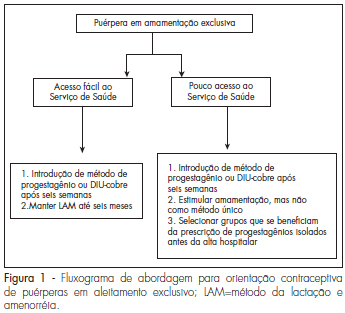
Summary
Revista Brasileira de Ginecologia e Obstetrícia. 2007;29(9):470-477
DOI 10.1590/S0100-72032007000900006
PURPOSE: to assess the prevalence of the risk of post-partum depression in women in the post-natal ward of a hospital in São Paulo city, in the southeastern region of Brazil, and analyze the associated factors, including domestic violence (DV). METHODS: this was a descriptive, cross-sectional study. The participants were 133 women with at least 20 weeks of gestation age, who delivered their babies from August to September 2005 in a tertiary maternity in the city of São Paulo (Brazil). They were interviewed using the Portuguese version of the Abuse Assessment Screen for the diagnosis of violence and filled out a self-evaluation questionnaire for post-partum depression (Edinburgh Postnatal Depression Scale). Variables were presented as absolute and relative frequencies. The chi2 or Fisher exact tests were used to analyze possible associations between the variables of interest and post-partum depression. The value of 5% was considered significant. RESULTS: risk for post-partum depression was detected in 24 women (18%). A total of 38.3% of the participants interviewed had a history of abuse. There was an association between DV after they were 15 years old and risk of depression (p=0.036). The prevalence of abuse in the group of women at risk for post-partum depression was 58.3% and this was significantly higher than the 33.9% observed in the control group. CONCLUSIONS: the probability of presenting depression was high among the post-partum women attended at a tertiary maternity in the southeast of Brazil. The DV after they were 15 years old was significantly associated with risk of post-partum depression.
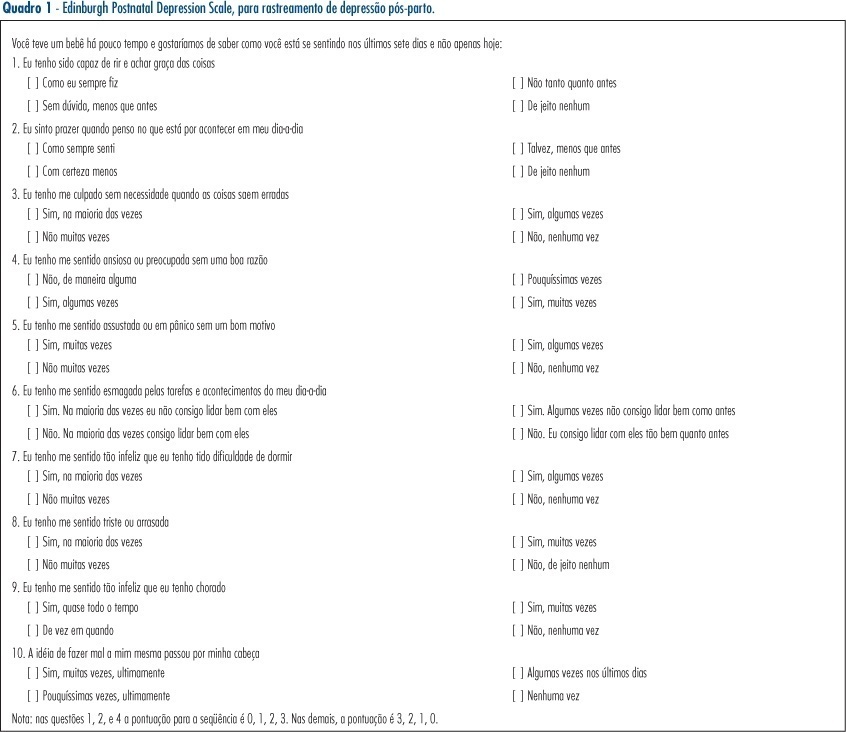
Summary
Revista Brasileira de Ginecologia e Obstetrícia. 2010;32(10):471-475
Summary
Revista Brasileira de Ginecologia e Obstetrícia. 2016;38(9):471-476
The Buschke-Loewenstein tumor is characterized by excessive growth of verrucous lesions on the genitals and/or perianal region. It is considered benign despite the high rate of recurrence and the possibility of malignant transformation. It is commonly associated with subtypes 6 and 11 of the human papillomavirus (HPV), and host 's immunity plays an important role in the development of the disease. Surgical excision is the recommended treatment in most cases. We present the case of a 16 years old female patient with extensive vulvar lesions successfully treated surgically.
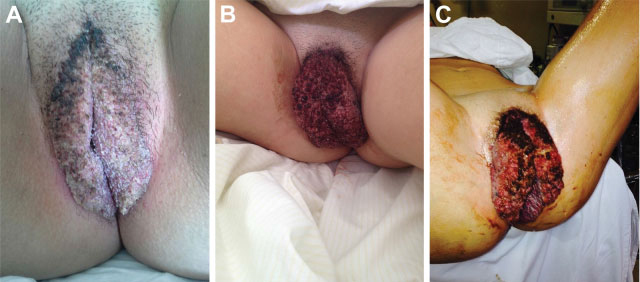
Summary
Revista Brasileira de Ginecologia e Obstetrícia. 2018;40(8):471-476
Evaluate the influence of prenatal care on the occurrence of gestational hypertension.
The Web of Science, Scopus, Pubmed, Cochrane and ClinicalTrials electronic databases were searched for articles published between January 1st, 2012 and December 31st, 2016. No language restrictions were imposed. The following keywords were used: prenatal care, medical assistance, prenatal education, pregnancy-induced hypertension. The preferred reporting items for systematic reviews and meta-analyses (PRISMA) checklist was employed. Two hundred and forty articles were identified during the initial search, but only seven met the inclusion criteria. This systematic review is registered with the international prospective register of systematic reviews (PROSPERO; #CRD42017064103).
The seven studies hada lowriskof bias,withmethodological quality scores ranging fromsix to eight points. Five studies found a positive relationship between prenatal care and pregnancy-induced hypertension, whereas two studies found no significant association between the two variables. The divergence among the studies may have been due to the type of healthcare service at which the study was conducted and the sample size.
Although the studies analyzed differed with regard to methodological aspects, the findings demonstrate the importance of prenatal care during the gestational period as a prevention and health promotion measure.
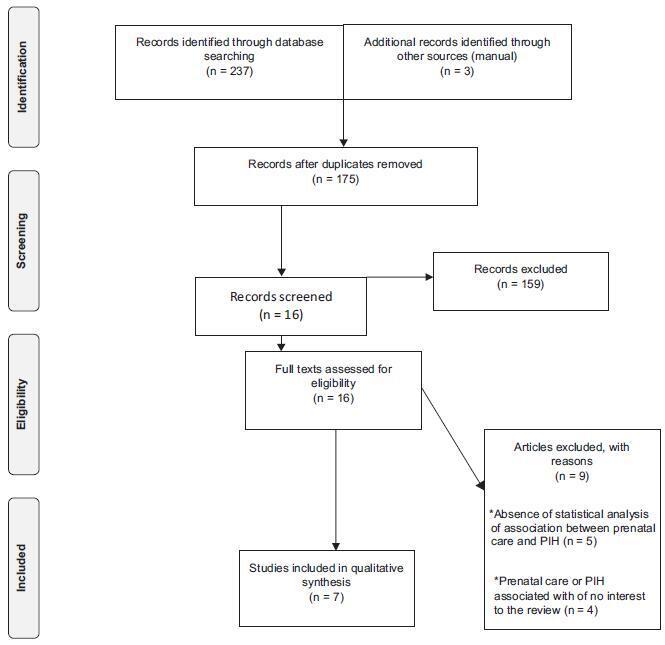
Summary
Revista Brasileira de Ginecologia e Obstetrícia. 2017;39(9):471-479
Using three-dimensional ultrasound (3D-US), we aimed to compare the tape position and the angle formed by the sling arms in different techniques of midurethral sling insertion for the surgical treatment of stress urinary incontinence, three years after surgery. In addition, we examined the correlations between the US findings and the clinical late postoperative results.
A prospective cross-sectional cohort study of 170 patients who underwent a sling procedure between May 2009 and December 2011 was performed. The final sample, with US images of sufficient quality, included 26 retropubic slings (tension-free vaginal tape, TVT), 42 transobturator slings (tension-free vaginal tape-obturator, TVTO), and 37 single-incision slings (tension-free vaginal tape-Secur, TVT-S). The images (at rest, during the Valsalva maneuver, and during pelvic floor contraction) were analyzed offline by 2 different observers blinded against the surgical and urinary continence status. Group comparisons were performed using the Student t-test, the chi-squared and the Kruskal-Wallis tests, and analyses of variance with Tukey multiple comparisons.
Differences among the groups were found in themean angle of the tape arms (TVT = 119.94°, TVT-O = 141.93°, TVT-S = 121.06°; p < 0.001) and in the distance between the bladder neck and the tape at rest (TVT = 1.65 cm, TVT-O = 1.93 cm, TVTS = 1.95 cm; p = 0.010). The global objective cure rate was of 87.8% (TVT = 88.5%, TVT-O = 90.5%, TVT-S = 83.8%; p = 0.701). The overall subjective cure rate was of 83.8% (TVT = 88.5%, TVT-O = 88.5% and TVT-S = 78.4%; p = 0.514). The slings were located in the mid-urethra in 85.7% of the patients (TVT = 100%, TVT-O = 73.8%, TVTS = 89.2%; p = 0.001), with a more distal location associated with obesity (distal: 66.7% obese; mid-urethra: 34% obese; p = 0.003). Urgency-related symptoms were observed in 23.8% of the patients (TVT = 30.8%, TVT-O = 21.4%, TVT-S = 21.6%; p = 0.630).
The angle formed by the arms of the sling tape was more obtuse for the transobturator slings compared with the angles for the retropubic or single-incision slings. Retropubic slings were more frequently located in the mid-urethra compared with the other slings, regardless of obesity. However, the analyzed sonographic measures did not correlate with the urinary symptoms three years after the surgery.
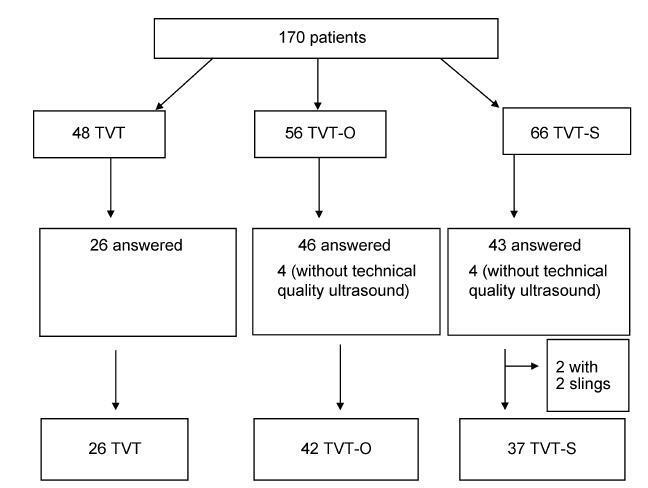
Summary
Revista Brasileira de Ginecologia e Obstetrícia. 2002;24(7):471-477
DOI 10.1590/S0100-72032002000700007
Purpose: to assess the diagnostic and therapeutic aspects and the complications of symptomatic urinary tract infections (UTI) during pregnancy of patients who were hospitalized. Methods: a total of 136 pregnant women with a clinical diagnosis of pyelonephritis were studied. The studied parameters were: age and parity of patients, gestational age of diagnosis, epidemiologic aspects, laboratory evaluation for UTI, treatment and clinic evolution, prophylaxis and complications. Results: pyelonephritis was diagnosed at the same proportions at all gestational ages. The incidence of UTI was higher among primigravidae. Only 29.3% of the pregnant women had a previous history of UTI; 57.0% were anemic and 93.0% had altered urinalysis. Escherichia coli was the most prevalent uropathogen (75.8% of cases), with low percentages of sensitivity to ampicillin (60.6%) and high percentages of sensitivity to cefuroxime (95,5%). The highest rate of clinical improvement was obtained for the pregnant women treated with cefuroxime (95.7%). Prophylaxis was needed in 11.0% of the patients. Preterm labor occurred in 33.3% of the pregnant women who delivered in our service and preterm delivery occurred in 18.9%. Conclusions: the present results support the need for an early diagnosis and effective treatment of UTI in pregnant women in order to prevent the frequent occurrence of perinatal complications such as premature labor and delivery. We emphasize the need of a periodical evaluation of the pattern of sensitivity of the etiologic agents to the antimicrobials allowed for use during pregnancy, with cefuroxime being adopted as the antibiotic of choice for the treatment of UTI during pregnancy.